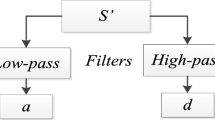Abstract
In this work, a new on-line method for detecting incipient failures in electrical motors is proposed. The method is based on monitoring certain statistical parameters estimated from the analysis of the steady state stator current (for broken bars, saturation, eccentricities, and bearing failures) or the axial flux signal (for coil short-circuits in the stator windings). The approach is based on the extraction of the envelop of the signal by Hilbert transformation, pre-multiplied by a Tukey window to avoid transient distortion. Then a wavelet analysis (multi-resolution analysis) is performed, which makes the fault diagnosis easier. Finally, based on a statistical analysis, the failure thresholds are determined. Thus, by monitoring the mean value estimate it is possible to detect an incipient failure condition on the machine.
Similar content being viewed by others
References
Barrios A (1997) Diagnosis of incipient failures in induction machines based on multi-resolution analysis and time-frequency decomposition. (In Spanish). Electrical Engineer Thesis, Department of Electrical Engineering, University of Chile, Santiago, Chile
Benbouzid M, Beguenane R, Viera M (1999) Induction motor asymmetrical faults detection using advanced signal processing techniques. IEEE Trans Energy Conver 14(2):146–152
Cameron JR, Thomson WT, Dow A (1986) Vibration and current monitoring for detecting air gap eccentricity in large induction motors. IEE Proc 133B(3):155–163
Combastel C, Lesecq S, Petropol S, Gentil S (2002) Model-based and wavelet approaches to induction motor on-line fault detection. Control Eng Pract 10(5):493–509
Daubechies I (1994) Ten lectures on wavelets. CBMS, SIAM 61:198–202, 254–256
Gallardo E (1996) Diagnosis of the electromechanical state of induction motors based on acceleration tests. (In Spanish). Electrical Engineer Thesis, Department of Electrical Engineering, University of Chile, Santiago, Chile
González D (1998) Development of patterns for failure recognition in induction motors through recording of transient phenomena. (In Spanish). Electrical Engineer Thesis, Department of Electrical Engineering, University of Chile, Santiago, Chile
Jacquelin J (1993) Generalization of the method of Maximum Likelihood. IEEE Trans Electr Insul 28(1):65–72
Jimenez GA (2003) Diagnosis of incipient failures in induction motors based on the envelope analysis. (In Spanish). M.Sc. Thesis, Department of Electrical Engineering, University of Chile, Santiago, Chile
Jimenez GA, Munoz A, Duarte M (2003) A new scheme for the analysis of failures in induction motors based on the measurement of the stator current. (In Spanish). In: Proceedings of the 10 Latin American regional workshop of CIGRE, May 18–22, 2003, Puerto Iguazú, Argentina. Proceedings in CD, Track No. 11–27, 6 pp
Kaiser G (1994) A friendly guide to wavelets. Department of Mathematics, University of Massachusetts. Birkhäuser
Kliman GB, Premerlani WJ, Yacizi B, Koegl R, Mazereeuw J (1997) Sensorless on line motor diagnostics. IEEE Comput Appl Power 10(2):39–43
Landy CF, Walliser RF (1994) Determination of interbar current effects in the detection of broken rotor bars in squirrel cage induction motors. IEEE Trans Energy Conv 9(1):152–158
Lazarevic Z, Petrovic D (2000) The advanced method of rotor failure detection in large induction motors. Session 2000 CIGRE 11–203. Paris
Lawrence M (1999) Computing the discrete-time ``analytic'' signal via FFT. IEEE Trans Signal Process 47(9):2600–2603
Long D (1998) Comments on Hilbert transform based signal analysis. MERS Technical Report MERS 95–005. Microwave Earth Remote Sensing Laboratory, Department of Electrical and Computer Engineering, Brigham Young University
Martelo A (2000) Fault detection of ball bearing in electrical motors by means of vibration, noise and stator current spectral analysis. (In Spanish). M.Sc Thesis, Department of Mechanical Engineering, University of Los Andes, Bogotá, Colombia
Meyer Y (1993) Wavelets: algorithms and applications. Society of Industrial and Applied Mathematics, Philadelphia
Montanari G, Mazzanti G, Cacciari M, Forthergill J (1997) Optimum estimators for the Weibull distribution of censored data. IEEE Trans Dielectr Electr Insul 4(4):462 – 469
Newland DE (1997) Practical signal analysis: Do wavelets make any difference ? In: Proceedings of 1997 ASME design engineering technical conferences, DETC′ 97. VIB-4135 September 1997
Paiva F, Riquelme R (2001) Wavelets and signal analysis I (In Spanish). Department of Mathematical Engineering, University of Concepción
Penman J, Sedding HG, Fink WT (1994) Detection and location of inter-turn short circuits in the stator windings of operating motors. IEEE Trans Energy Conv 9(4):652–658
Ross R (1994) Formulas to describe the bias and standard deviation of the ML-estimated Weibull shape parameter. IEEE Trans Dielectr Electr Insul 1(2):247–253
Ross R (1996) Bias and standard deviation due to Weibull parameter estimation for small data sets. IEEE Trans Dielectr and Electr Insul 3(1):28–42
Schoen R, Habetler T, Kamran F, Bartheld R (1995) Motor bearing damage detection using stator current monitoring. IEEE Trans Ind Appl 31(6):1274–1279
Smith JO Mathematics of the discrete fourier transform (DFT) . Center for Computer Research in Music and Acoustics (CCRMA), Stanford University, 2002. Web published at http://www-ccrma.stanford.edu/~jos/mdft/
Sottile J, Kohler J (1993) An on line method to detect incipient failure of turn insulation in random wound motors. IEEE Trans Energy Conv 8(4):762–768
Stone G, Campbell S, Tetreault S (2000) Inverter-fed drives: which motor stators are at risk?. IEEE Ind Appl Mag 6(5):17–22
Tallam R, Habetler T, Harley R (2002) Transient model for induction machines with stator winding turn faults. IEEE Trans Ind Appl 38(3):632–637
The Mathworks Inc (2001) Signal processing toolbox. Matlab, The language of technical computing. Version 6.1.0.450, Release 12.1. May 2001
Thomson WT, Fenger M (2001) Current signature analysis to detect induction motor faults. IEEE Ind Appl Mag 7(4):26–34
Toliyat H, Nandi S (2002) Novel frequency-domain-based technique to detect stator inter-turn faults in induction machines using stator-induced voltages after switch-off. IEEE Trans Ind Appl 38(1):101–109
Williamson S, Mirzoian K (1985) Analysis of cage induction motors with stator winding faults. IEEE Trans Power Apparatus Syst PAS-104(7):1838–1842
Yacizi B, Kliman G (1999) An adaptive statistical time frequency method for detection of broken bars and bearing faults in motors using stator current. IEEE Trans Ind Appl 35(2):442–452
Author information
Authors and Affiliations
Corresponding author
Rights and permissions
About this article
Cite this article
Jiménez, G., Muñoz, A. & Duarte-Mermoud, M. Fault detection in induction motors using Hilbert and Wavelet transforms. Electr Eng 89, 205–220 (2007). https://doi.org/10.1007/s00202-005-0339-6
Received:
Accepted:
Published:
Issue Date:
DOI: https://doi.org/10.1007/s00202-005-0339-6




